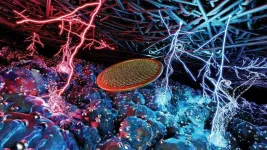(Press-News.org) Over the course of nearly five months in 2022, NASA's Perseverance rover collected rock samples from Mars that could rewrite the history of water on the Red Planet and even contain evidence for past life on Mars.
But the information they contain can't be extracted without more detailed analysis on Earth, which requires a new mission to the planet to retrieve the samples and bring them back. Scientists hope to have the samples on Earth by 2033, though NASA's sample return mission may be delayed.
"These samples are the reason why our mission was flown," said paper co-author David Shuster, professor of earth and planetary science at the University of California, Berkeley, and a member of NASA’s science team for sample collection. "This is exactly what everyone was hoping to accomplish. And we've accomplished it. These are what we went looking for."
The critical importance of these rocks, sampled from river deposits in a dried-up lake that once filled a crater called Jezero, is detailed in a study to be published Aug. 14 in AGU Advances, a journal of the American Geophysical Union.
"These are the first and only sedimentary rocks that have been studied and collected from a planet other than Earth," said paper co-author David Shuster, professor of earth and planetary science at the University of California, Berkeley, and a member of NASA’s science team for sample collection. "Sedimentary rocks are important because they were transported by water, deposited into a standing body of water and subsequently modified by chemistry that involved liquid water on the surface of Mars at some point in the past. The whole reason that we came to Jezero was to study this sort of rock type. These are absolutely fantastic samples for the overarching objectives of the mission."
Shuster is co-author of the paper with first author Tanja Bosak, a geobiologist at the Massachusetts Institute of Technology (MIT) in Cambridge.
"These rock cores are likely the oldest materials sampled from any known environment that may have supported life," Bosak said. "When we bring them back to Earth, they can tell us so much about when, why and for how long Mars contained liquid water, and whether some organic, prebiotic and potentially even biological evolution may have taken place on that planet."
Significantly, some of the samples contain very fine-grained sediments that are the most likely type of rock to retain evidence of past microbial life on Mars — if there ever was or is life on the planet.
"Liquid water is a key element in all of this because it is the key ingredient for biological activity, as far as we understand it," said Shuster, a geochemist. "Fine-grained sedimentary rocks on Earth are those that are most likely to preserve signatures of past biological activity, including organic molecules. That's why these samples are so important."
NASA announced on July 25 that Perseverance had collected new rock samples from an outcrop named Cheyava Falls that also might contain signs of past life on Mars. The rover's scientific instruments detected evidence of organic molecules, while "leopard spot" inclusions in the rocks are similar to features that on Earth are often associated with fossilized microbial life.
In a statement, Ken Farley, Perseverance project scientist at Caltech, said, “Scientifically, Perseverance has nothing more to give. To fully understand what really happened in that Martian river valley at Jezero crater billions of years ago, we’d want to bring the Cheyava Falls sample back to Earth, so it can be studied with the powerful instruments available in laboratories.”
Sediments hold the answers
Shuster noted that Jezero and the fan of sediments left behind by the river that once flowed into it likely formed 3.5 billion years ago. That abundant water is now gone, either trapped underground or lost to space. But Mars was wet at a time when life on Earth — in the form of microbes — was already everywhere.
"Life was doing its thing on Earth at that point in time, 3.5 billion years ago," he said. "The basic question is: Was life also doing its thing on Mars at that point in time?"
"Anywhere on Earth over the last 3.5 billion years, if you give me the scenario of a river flowing into a crater transporting materials to a standing body of water, biology would have taken hold there and left its mark, in one way or another," Shuster said. "And in the fine-grained sediment, specifically, we would have a very good chance of recording that biology in the laboratory observations that we can make on that material on Earth."
Shuster and Bosak acknowledge that the organic analysis equipment aboard the rover did not detect organic molecules in the four samples from the sedimentary fan. Organic molecules are used and produced by the type of life we're familiar with on Earth, though their presence is not unequivocal evidence of life.
"We did not clearly observe organic compounds in these key samples," Shuster said. "But just because that instrument did not detect organic compounds does not mean that they are not in these samples. It just means they weren't at a concentration detectable by the rover instrumentation in those particular rocks."
To date, Perseverance has collected a total of 25 samples, including duplicates and atmospheric samples, plus three "witness tubes" that capture possible contaminants around the rover. Eight duplicate rock samples plus an atmospheric sample and witness tube were deposited in the so-called Three Forks cache on the surface of Jezero as a backup in case the rover suffers problems and the onboard samples can't be retrieved. The other 15 samples — including the Cheyava Falls sample collected July 21 — remain aboard the rover awaiting recovery.
Shuster was part of a team that analyzed the first eight rock samples collected, two from each site on the crater floor, all of which were igneous rocks likely created when a meteor impact smashed into the surface and excavated the crater. Those results were reported in a 2023 paper, based on analyses by the instruments aboard Perseverance.
The new paper is an analysis of seven more samples, three of them duplicates now cached on Mars' surface, collected between July 7 and November 29 of 2022 from the front of the western sediment fan in Jezero. Bosak, Shuster and their colleagues found the rocks to be composed mostly of sandstone and mudstone, all created by fluvial processes.
"Perseverance encountered aqueously deposited sedimentary rocks at the front, top and margin of the western Jezero fan and collected a sample suite composed of eight carbonate-bearing sandstones, a sulfate-rich mudstone, a sulfate-rich sandstone, a sand-pebble conglomerate," Bosak said. "The rocks collected at the fan front are the oldest, whereas the rocks collected at the fan top are likely the youngest rocks produced during aqueous activity and sediment deposition in the western fan."
While Bosak is most interested in possible biosignatures in the fine-grained sediments, the coarse-grained sediments also contain key information about water on Mars, Shuster said. Though less likely to preserve organic matter or potential biological materials, they contain carbonate materials and detritus washed from upstream by the now-vanished river. They thus could help determine when water actually flowed on Mars, the main emphasis of Shuster's own research.
"With lab analysis of those detrital minerals, we could make quantitative statements about when the sediments were deposited and the chemistry of that water. What was the pH (acidity) of that water when those secondary phases precipitated? At what point in time was that chemical alteration taking place?" he said. "We have this combination of samples now in the sample suite that are going to enable us to understand the environmental conditions when the liquid water was flowing into the crater. When was that liquid water flowing into the crater? Was it intermittent?"
Answers to these questions rely upon analyses of the returned materials in terrestrial laboratories to uncover the organic, isotopic, chemical, morphological, geochronological and paleomagnetic information they record, the researchers emphasized.
"One of the most important planetary science objectives is to bring these samples back," Shuster said.
END
Rocks collected on Mars hold key to water and perhaps life on the planet. Bring them back to Earth.
Only Earth-based analysis of sediments gathered by rover can retrieve clues to Mars' water history
2024-08-14
ELSE PRESS RELEASES FROM THIS DATE:
Nighttime light data shows inequities in restoring power after Hurricane Michael
2024-08-14
Among the many devasting impacts in the aftermath of a hurricane are power outages, which can take days or even weeks to restore. Communities grappling with the loss of electricity may encounter obstacles in accessing vital services, including food, fuel and health care.
In 2018, Hurricane Michael, a Category 5 storm, wreaked havoc in Florida as it made landfall in the United States. It was strongest recorded to hit the Florida Panhandle with winds of nearly 161 miles per hour and storm surge reaching heights ...
Rising mercury pollution in soil could be related to climate change, study says
2024-08-14
In 2017, the Minamata Convention on Mercury went into effect, designed to help curb mercury emissions and limit exposure across the globe. However, a new study of mercury levels in soil suggests that the treaty’s provisions might not be enough. The study published in ACS’ Environmental Science & Technology estimates that soil stores substantially more mercury than previously thought, and it predicts that increases in plant growth due to climate change may add even more.
Mercury is a persistent environmental pollutant, moving through air, water and soil, and accumulating within plants ...
Exploring the structures of xenon-containing crystallites
2024-08-14
Noble gases have a reputation for being unreactive, inert elements, but more than 60 years ago Neil Bartlett demonstrated the first way to bond xenon. He created XePtF6, an orange-yellow solid. Because it’s difficult to grow sufficiently large crystals that contain noble gases, some of their structures — and therefore functions — remain elusive. Now, researchers have successfully examined tiny crystallites of noble gas compounds. They report structures of multiple xenon compounds in ACS Central ...
Oral cancer screening: Insights into epidemiology, risk factors, and screening programs for improved early detection
2024-08-14
Cancer is a complex disease characterized by uncontrolled cell growth, significantly impacting global health. Head and neck cancers rank as the sixth most prevalent cancers worldwide, with a higher incidence in South-central Asia. Oral squamous cell carcinoma (OSCC) is the predominant malignancy in this category, posing a significant health concern due to its high mortality and often late-stage diagnosis. The significance of early detection and appropriate screening measures cannot be overstated, as they play a pivotal role in improving survival rates and reducing the disease burden.
Overview ...
AAAS and Chen Institute inaugurate new prize recognizing innovative applications of AI techniques
2024-08-14
In collaboration with the Tianqiao and Chrissy Chen Institute, the American Association for the Advancement of Science (AAAS) is announcing the establishment of the Chen Institute and Science Prize for Al Accelerated Research. Submissions are now open for the first year of the prize, which will be awarded in 2025.
The prize will recognize young researchers who apply techniques in artificial intelligence (AI) – such as machine learning, natural language processing, or computer vision – to help the life sciences research community solve important problems and accelerate their work. Successful applicants will have made a fundamental advance that would not have been ...
A method that paves the way for improved fuel cell vehicles
2024-08-14
More efficient and longer-lasting fuel cells are essential for fuel cell-powered heavy-duty hydrogen vehicles to be an alternative to combustion fuelled counterparts. Researchers at Chalmers University of Technology, Sweden, have developed an innovative method to study and understand how parts of fuel cells degrade over time. This is an important step towards the improved performance of fuel cells and them becoming commercially successful.
Hydrogen is a fuel alternative that is becoming increasingly interesting for heavy-duty vehicles. Hydrogen-powered vehicles only emit water vapour as exhaust, and if the hydrogen is produced using renewable energy, it is completely free ...
How air-powered computers can prevent blood clots
2024-08-14
A new, air-powered computer sets off alarms when certain medical devices fail. The invention is a more reliable and lower-cost way to help prevent blood clots and strokes — all without electronic sensors.
Described in a paper in the journal Device, the computer not only runs on air, but also uses air to issue warnings. It immediately blows a whistle when it detects a problem with the lifesaving compression machine it is designed to monitor.
Intermittent pneumatic compression or IPC devices are leg sleeves that fill with air periodically and ...
Fear of appearing prejudiced can inhibit accurate performance feedback to women
2024-08-14
PULLMAN, Wash. – Evaluators who want to avoid appearing prejudiced may overcorrect and give women inflated performance feedback, new research indicates, which is a practice that could ultimately hinder their ability to improve and advance.
A Washington State University-led research team investigated the connection between overly positive performance reviews and “protective paternalism,” the belief that women need to be handled carefully and shielded from harm.
While it may be well-intentioned, ...
Chromatin structure plays a key role in canine social behavior evolution
2024-08-14
A new study on dogs found that chromatin's spatial structure has a significant role in the evolution of social behavior. Chromatin, the compact form of DNA, not only packages genetic material but also plays a crucial role in gene regulation. This study demonstrates that both the linear sequence of DNA and its three-dimensional configuration are linked to friendly behavior shaped by dog domestication, providing new insights into the molecular mechanisms underlying social traits.
Behavioral traits such as sociability are influenced by numerous genes, their interactions, environmental factors, and individual life experiences.
Because ...
Work-related stress may increase the risk of an irregular heart rhythm
2024-08-14
Research Highlights:
Adults in white-collar jobs in Canada with high job strain and for whom significant efforts are met with low rewards (such as low salary or recognition) may face a 97% increased risk for developing the irregular heart rhythm condition known as atrial fibrillation, or AFib or AF, compared to workers not exposed to these work stressors.
Separately, high job strain alone was associated with an 83% higher risk of developing AFib, and effort-reward imbalance alone was associated with a 44% greater risk.
Recognizing and addressing these stressors at work may be an effective strategy ...
LAST 30 PRESS RELEASES:
Decoupling the HOR enhancement on PtRu: Dynamically matching interfacial water to reaction coordinates
Sulfur isn’t poisonous when it synergistically acts with phosphine in olefins hydroformylation
URI researchers uncover molecular mechanisms behind speciation in corals
Chitin based carbon aerogel offers a cleaner way to store thermal energy
Tracing hidden sources of nitrate pollution in rapidly changing rural urban landscapes
Viruses on plastic pollution may quietly accelerate the spread of antibiotic resistance
Three UH Rainbow Babies & Children’s faculty elected to prestigious American Pediatric Society
Tunnel resilience models unveiled to aid post-earthquake recovery
Satellite communication systems: the future of 5G/6G connectivity
Space computing power networks: a new frontier for satellite technologies
Experiments advance potential of protein that makes hydrogen sulfide as a therapeutic target for Alzheimer’s disease
Examining private equity’s role in fertility care
Current Molecular Pharmacology achieves a landmark: real-time CiteScore advances to 7.2
Skeletal muscle epigenetic clocks developed using postmortem tissue from an Asian population
Estimating unemployment rates with social media data
Climate policies can backfire by eroding “green” values, study finds
Too much screen time too soon? A*STAR study links infant screen exposure to brain changes and teen anxiety
Global psychiatry mourns Professor Dan Stein, visionary who transformed mental health science across Africa and beyond
KIST develops eco-friendly palladium recovery technology to safeguard resource security
Statins significantly reduce mortality risk for adults with diabetes, regardless of cardiovascular risk
Brain immune cells may drive more damage in females than males with Alzheimer’s
Evidence-based recommendations empower clinicians to manage epilepsy in pregnancy
Fungus turns bark beetles’ defenses against them
There are new antivirals being tested for herpesviruses. Scientists now know how they work
CDI scientist, colleagues author review of global burden of fungus Candida auris
How does stroke influence speech comprehension?
B cells transiently unlock their plasticity, risking lymphoma development
Advanced AI dodel predicts spoken language outcomes in deaf children after cochlear implants
Multimodal imaging-based cerebral blood flow prediction model development in simulated microgravity
Accelerated streaming subgraph matching framework is faster, more robust, and scalable
[Press-News.org] Rocks collected on Mars hold key to water and perhaps life on the planet. Bring them back to Earth.Only Earth-based analysis of sediments gathered by rover can retrieve clues to Mars' water history






